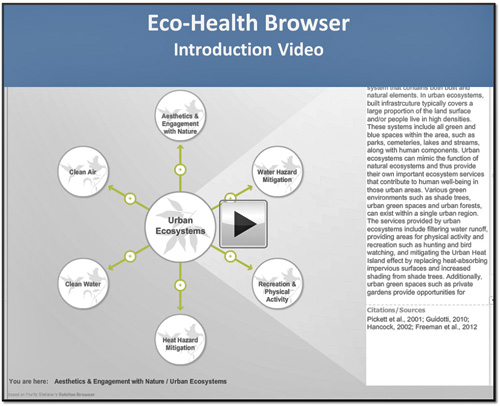Navigation
EnviroAtlas Ecosystem Mapping Tool Launched by US EPA
- Agriculture
- agriculture
- ecosystem services
- EnviroAtlas
- EPA
- geospatial data
- habitats
- human well-being
- Landscape America
- natural resources
- U.S. Environmental Protection Agency
- urban forests
- urban greenspaces
- wetlands
- Biodiversity
- Desertification
- Endangered Species
- Forests
- Global Climate Change
- News and Special Reports
- Rivers
- Water
The U.S. Environmental Protection Agency (EPA) on 6 May 2014 released EnviroAtlas, a web-based interactive tool that integrates over 300 separate data layers, helps decision makers understand the implications of planning and policy decisions on our fragile ecosystems and the communities who depend on goods and services from these ecosystems. EnviroAtlas is available to the public and houses a wealth of data and research.
 EnviroAtlas is designed for people from all levels of government, professionals, researchers,: educators, non-governmental organizations, and anyone interested in considering the benefits or impacts of a decision, such as siting a new road or city park. Image courtesy of the US EPA.
EnviroAtlas is designed for people from all levels of government, professionals, researchers,: educators, non-governmental organizations, and anyone interested in considering the benefits or impacts of a decision, such as siting a new road or city park. Image courtesy of the US EPA.
The U.S. Environmental Protection Agency (EPA) on 6 May 2014 released EnviroAtlas, a web-based interactive tool that integrates over 300 separate data layers, helps decision makers understand the implications of planning and policy decisions on our fragile ecosystems and the communities who depend on goods and services from these ecosystems. EnviroAtlas is available to the public and houses a wealth of data and research.
The EPA says, “Though critically important to human well-being, ecosystem services are often overlooked. EnviroAtlas seeks to measure and communicate the type, quality, and extent of the goods and services that humans receive from nature so that their true value can be considered in decision-making processes… users can access, view, and analyze diverse information to better understand how various decisions can affect an array of ecological and human health outcomes.”
EnviroAtlas can help people learn about ecosystems, and how they provide us with benefits such as clean air and water; opportunities for recreation; and protection from severe weather, such as hurricanes and floods. EnviroAtlas also highlights how ecosystems provide habitats for plants, fish, and wildlife as well as the materials people need to produce food, clothing, shelter, and pharmaceuticals, and provides maps on all of these topics.
EnviroAtlas Interactive Map
 A multi-scaled Interactive Map with broad scale data for the lower 48 states and fine scale data for selected communities
A multi-scaled Interactive Map with broad scale data for the lower 48 states and fine scale data for selected communities
“Our health and well-being, our economy and our security depend upon healthy ecosystems,” says Bob Perciasepe, Deputy Administrator of EPA, “By providing EnviroAtlas, which contains a wealth of information for the United States, EPA is helping to ensure that anyone making decisions that may impact ecosystems will have the best available knowledge to build prosperous communities while conserving our natural resources.”
EnviroAtlas integrates geospatial data from a variety of sources to allow users to visualize and analyze how decisions impact ecosystems and their ability to provide goods and services. Communities are often faced with difficult decisions, such as trade-offs between transportation, residential or commercial development and maintaining local wetlands, urban greenspaces, or urban forests. EnviroAtlas helps communities better understand the potential benefits and drawbacks of their decisions by providing data, maps, information and tools to analyze relationships between nature, health and well-being, and the economy.
EnviroAtlas combines hundreds of data layers developed through collaboration between EPA, US Geological Survey, US Forest Service, other federal, state, and non-profit organizations, and several universities. Using powerful web application tools, it lets users generate customized maps and images that show the condition of their local community’s air, water, and landscape; as well as population density and other demographic data. Users can investigate land cover patterns, see how ecosystem services reduce pollution, and view closer to true scale data to compare them across selected communities.
EnviroAtlas is available to anybody with access to a computer and an internet connection. No special software is needed. It is currently not optimized for smartphone or tablet use, but a mobile-friendly version is planned for the future.
Using tools like EnviroAtlas to make informed decisions will help ensure that people can continue to enjoy economic, social, and environmental benefits of ecosystems now and in the future.
What is EnviroAtlas?
EnviroAtlas is a collection of interactive tools and resources that allows users to explore the many benefits people receive from nature, often referred to as ecosystem services. Key components of EnviroAtlas include the following:
- A multi-scaled Interactive Map with broad scale data for the lower 48 states and fine scale data for selected communities
- The Eco-Health Relationship Browser, which shows the linkages between ecosystems, the services they provide, and human health
- Ecosystem services information, GIS and analysis tools, and written resources
About Us:
EnviroAtlas is a collaborative project developed by EPA, in cooperation with the US Geological Survey (USGS), the US Department of Agriculture's Natural Resources Conservation Service (NRCS) and Forest Service, and Landscope America, a collaborative project of NatureServe and the National Geographic Society. Produced by the collective effort of federal employees, contractors, and non-governmental organizations, EnviroAtlas develops and incorporates data from federal, state, community, and non-governmental organizations.
This news is from the U.S. Environmental Protection Agency (EPA), 6 May 2014. This article was published on the Horizon International Solutions Site on 9 May 2014.
Related Resource:
The Eco-Health Relationship Browser illustrates scientific evidence for linkages between human health and ecosystem services—benefits supplied by Nature. This interactive tool provides information about several of our nation's major ecosystems, the services they provide, and how those services, or their degradation and loss, may affect people.
 The Eco-Health Relationship Browser illustrates scientific evidence for linkages between human health and ecosystem services: The Eco-Health Relationship Browser illustrates scientific evidence for linkages between human health and ecosystem services. Image courtesy of US EPA.
The Eco-Health Relationship Browser illustrates scientific evidence for linkages between human health and ecosystem services: The Eco-Health Relationship Browser illustrates scientific evidence for linkages between human health and ecosystem services. Image courtesy of US EPA.
Link to the health browser is: http://enviroatlas.epa.gov/enviroatlas/tools/EcoHealth_RelationshipBrowser/introduction.html
Ecosystems such as wetlands and forests provide a wide variety of goods and services, many of which we use every day. However, some of these services, such as air filtration, are not obvious and therefore it may be hard to understand the impact they have on our daily lives. Scientific studies have documented many tangible and intangible services and health benefits that are provided by our surrounding ecosystems. This tool is designed so that users can easily explore the services ecosystems provide and how those services affect human health and well- being.
The research summarized in this tool represents a broad selection of recent evidence; it is not exhaustive. In addition, many of the cited studies do not prove cause-and-effect relationships, but highlight statistically significant, plausible associations in space and time. For some topics, causality is unknown and may be speculative. Inconclusive findings have been noted; such studies, as well as issues of causality, can be explored through the online bibliography. Documentation of the literature review and inclusion criteria for this tool appears in the International Journal of Public Health, July, 2013 (DOI 10.1007/s00038-013-0482-1). For more information, contact Laura Jackson atjackson.laura@epa.gov.
Search
Latest articles
Agriculture
- World Water Week: Healthy ecosystems essential to human health: from coronavirus to malnutrition Online session Wednesday 24 August 17:00-18:20
- World Water Week: Healthy ecosystems essential to human health: from coronavirus to malnutrition Online session Wednesday 24 August 17:00-18:20
Air Pollution
- "Water and Sanitation-Related Diseases and the Changing Environment: Challenges, Interventions, and Preventive Measures" Volume 2 Is Now Available
- Global Innovation Exchange Co-Created by Horizon International, USAID, Bill and Melinda Gates Foundation and Others
Biodiversity
- It is time for international mobilization against climate change
- World Water Week: Healthy ecosystems essential to human health: from coronavirus to malnutrition Online session Wednesday 24 August 17:00-18:20
Desertification
- World Water Week: Healthy ecosystems essential to human health: from coronavirus to malnutrition Online session Wednesday 24 August 17:00-18:20
- UN Food Systems Summit Receives Over 1,200 Ideas to Help Meet Sustainable Development Goals
Endangered Species
- Mangrove Action Project Collaborates to Restore and Preserve Mangrove Ecosystems
- Coral Research in Palau offers a “Glimmer of Hope”
Energy
- Global Innovation Exchange Co-Created by Horizon International, USAID, Bill and Melinda Gates Foundation and Others
- Wildlife Preservation in Southeast Nova Scotia
Exhibits
- Global Innovation Exchange Co-Created by Horizon International, USAID, Bill and Melinda Gates Foundation and Others
- Coral Reefs
Forests
- NASA Satellites Reveal Major Shifts in Global Freshwater Updated June 2020
- Global Innovation Exchange Co-Created by Horizon International, USAID, Bill and Melinda Gates Foundation and Others
Global Climate Change
- It is time for international mobilization against climate change
- It is time for international mobilization against climate change
Global Health
- World Water Week: Healthy ecosystems essential to human health: from coronavirus to malnutrition Online session Wednesday 24 August 17:00-18:20
- More than 400 schoolgirls, family and teachers rescued from Afghanistan by small coalition
Industry
- "Water and Sanitation-Related Diseases and the Changing Environment: Challenges, Interventions, and Preventive Measures" Volume 2 Is Now Available
- Global Innovation Exchange Co-Created by Horizon International, USAID, Bill and Melinda Gates Foundation and Others
Natural Disaster Relief
- STOP ATTACKS ON HEALTH CARE IN UKRAINE
- Global Innovation Exchange Co-Created by Horizon International, USAID, Bill and Melinda Gates Foundation and Others
News and Special Reports
- World Water Week: Healthy ecosystems essential to human health: from coronavirus to malnutrition Online session Wednesday 24 August 17:00-18:20
- STOP ATTACKS ON HEALTH CARE IN UKRAINE
Oceans, Coral Reefs
- World Water Week: Healthy ecosystems essential to human health: from coronavirus to malnutrition Online session Wednesday 24 August 17:00-18:20
- Mangrove Action Project Collaborates to Restore and Preserve Mangrove Ecosystems
Pollution
- Zakaria Ouedraogo of Burkina Faso Produces Film “Nzoue Fiyen: Water Not Drinkable”
- "Water and Sanitation-Related Diseases and the Changing Environment: Challenges, Interventions, and Preventive Measures" Volume 2 Is Now Available
Population
- "Water and Sanitation-Related Diseases and the Changing Environment: Challenges, Interventions, and Preventive Measures" Volume 2 Is Now Available
- "Water and Sanitation-Related Diseases and the Changing Environment: Challenges, Interventions, and Preventive Measures" Volume 2 Is Now Available
Public Health
- Honouring the visionary behind India’s sanitation revolution
- Honouring the visionary behind India’s sanitation revolution
Rivers
- World Water Week: Healthy ecosystems essential to human health: from coronavirus to malnutrition Online session Wednesday 24 August 17:00-18:20
- Mangrove Action Project Collaborates to Restore and Preserve Mangrove Ecosystems
Sanitation
- Honouring the visionary behind India’s sanitation revolution
- Honouring the visionary behind India’s sanitation revolution
Toxic Chemicals
- "Water and Sanitation-Related Diseases and the Changing Environment: Challenges, Interventions, and Preventive Measures" Volume 2 Is Now Available
- Actions to Prevent Polluted Drinking Water in the United States
Transportation
- "Water and Sanitation-Related Diseases and the Changing Environment: Challenges, Interventions, and Preventive Measures" Volume 2 Is Now Available
- Urbanization Provides Opportunities for Transition to a Green Economy, Says New Report
Waste Management
- Honouring the visionary behind India’s sanitation revolution
- Honouring the visionary behind India’s sanitation revolution
Water
- Honouring the visionary behind India’s sanitation revolution
- Honouring the visionary behind India’s sanitation revolution
Water and Sanitation
- Honouring the visionary behind India’s sanitation revolution
- Honouring the visionary behind India’s sanitation revolution

